The agenda today: More stars on the charts! Everything else would be icing on the cake, as they say. Soon after we arrived at the property, several Grade Three students appeared for their lunch. Wait, what are they doing here? They’re not due till 12:00!? Theresa asked them, “Why are you here now?” They said their class time had been changed. They now go to school at 12:30. Uh-oh. This puts a monkey wrench in our schedule. No, problem. We can start with them now and move another class till later.
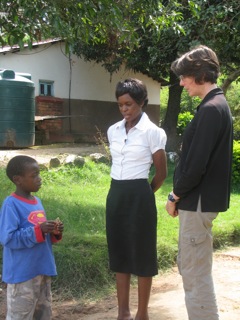
Joy and Jen asking students what time they are due in school today.
But, look, what are those two Grade One students doing here now? Again, Theresa inquires. Now we find out they have been “chased” from school. Annual fees are due in January, on or before the first day of school. In a community like Kantolomba almost no one has paid by then. Sometime around mid-March, Theresa tells us, some schools begin sending children home whose families have not paid the fees. Over the course of the day it was clear that a great number of our students had not paid their fees, had been dismissed from school, and were arriving at Living Compassion at odd hours. Imagine, as a 7-year-old, that the time to start your school day is frequently changing and you have no clock or watch at your house and no parent home to tell you it is time to set off for school. It is a wonder they get anywhere close to the right timing! And then, one day you arrive at school only to be turned away because your fees have not been paid.
This had us scratching our heads and, to be honest, a bit overwhelmed at how to wrangle the realities of life in Kantolomba into some semblance of a learning-conducive routine. Yikes.
But something fabulous happened as we continued on with the attendance charts, taking the students as they came, walking them through finding their names on the chart and putting a star by it.
Yes, it is impossible to keep a fixed schedule where all the children come at one time in a certain grade, etc., BUT it is completely possible to train the children to show up to put a star on the chart by their name. And they did!!! Out of the 170 students now enrolled in the Living English program (the students who have opted in to extra lessons after school and will be eligible for the field trips program) about 40% were All Stars today. “All Stars” are students who have all stars, no blank spaces by their name. So, for now, the All Stars are children who came both Monday and Friday. This was a monumental moment. 40% of the children, against all odds (some factors enumerated above and many more that would take us weeks to elaborate) grasp the concept of reporting to the correct place and teacher to join the class and put a star by their name—and have shown up two days in a row!! Huge congratulations were awarded to the All Stars.
And, later in the day, we grown-ups offered huge congratulations to one another. What we got is, all we need do is stick to this routine, like a dog with a bone, and let all the other factors sort themselves out. What the children will get is that although the time they go to school may change and their parents may or may not be home to assist them and they may or may not be able to go to school on a given day, here, at Living Compassion they belong, they are important, and we want them here EVERY day.
And, from what we hear, mid-March fee collecting and scheduling oddities will subside. Most families will go to the school and create a payment plan for the fees, and soon the classes will settle into a more regular routine.
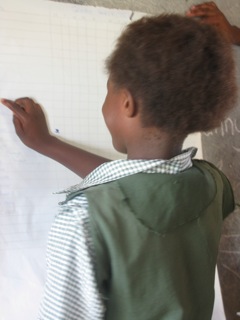
Finding your name on the chart

And making a star

The first group of All Stars!!!
Throughout the day there were “little” miracles that made us all so grateful and excited:
-Georgina’s daughter, Testimony, felt very sick in the morning. She cried, saying she wanted to go to Living Compassion so she could put a star by her name. Her mom reminded her she can still get a star as long as someone explains she is sick.
-3 parents came to report their child was sick! This NEVER happens!
-Mirriam, a grade 8 student who had been late to extra lessons due to chores duty at school (so missed the stars on the chart part), was leaving at the end of the day and then ran back. "Wait, I didn't put my star on the chart!"
And this is only day 2. The teachers are 100% in agreement that all we are doing now is learning/training what it means to be part of something, to show up, to be recognized, to make your presence known, to have it matter that you attend. The language of "Have you put your star on the chart today?" is a far more tangible, fun way to check in on participation than "Did you go to school today?"
And there are so many mini-lessons within this simple process: finding your name on the list; learning to put a star in the box under M for Monday, T for Tuesday; what an excused and unexcused absence is, etc.
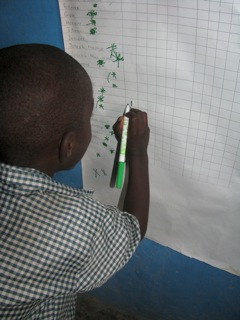

A gallery of grade one students making their stars.

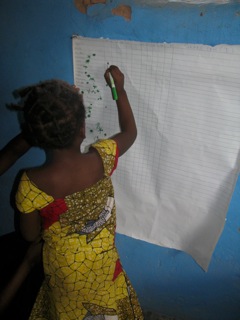
We never got tired of it! As some of the Grade Two students were waiting for their classmates to arrive, we took the opportunity to get in some good English practice. Up on the wall is a poster with pictures of dogs, chickens, cats, goats, and other animals. We came up with a game to learn the difference between singular and plural: one dog, two dogs. We counted together: one dog, two dogs, three dogs, four dogs. Then we skipped back to “one dog” and repeated it together until we couldn’t hear any s’s at the end! It was fun watching the game be created as we went, and watching more students pick up the game as they came in to join us.
Outside, Theresa had just asked Josephine if she would like to join the teaching team as an assistant. She said that yes, she would enjoy that. And what better time to start than now! Josephine came into the classroom, picked up the game, and took over playing it with the students. She is great with the children.
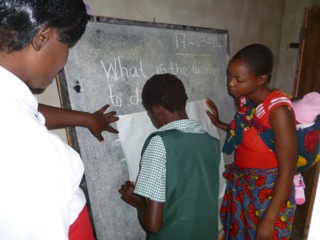
Josephine, with Baby Eunice on her back, jumps in to assist.
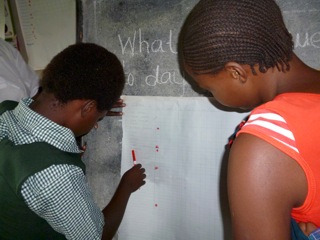
Helping a student find her name
We finally caught up with some of the Grade Five students today. They had been missing from our enrollment because the time of their school day had also changed, and it was only now that word was getting around what time they should report for Living English.

Theresa explaining the procedure to a group of Grade Five students.
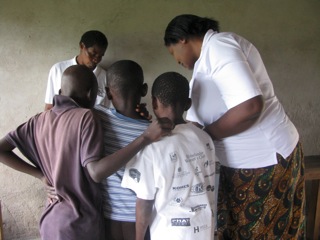
And showing them the attendance charts
Once a quorum of the teachers were freed up, Anna had a stellar session training on filling out a template we have created for letting us know how the Living English program is going once we are back in the U.S. With each trip, the quality of far-flung communication gets better. One big advantage we have from this trip is the excellent legwork we all did to document the children entering Living English. We have photos tagged with names, ages, grade-level (and any relations to coop members, etc.) for all 170 children. That was a feat in itself—and a great deal of fun!
After lunch, we worked with the grown-ups—more learning how to learn, more modeling how to learn. On our last trip, as we documented in that blog, the humble rubber band became a powerful tool for training listener-friendly pronunciation. You loop it around your hands, and stretch it when you pronounce the lengthened, stretched-out, stressed syllable: “absoLUTEly” became our favorite word to practice.
Don’t have a rubber band on hand? No problem, you can just move your hands apart in time with the stress. We had left the team with the encouragement that every time they learn a new word, it is important to learn where the stress is, so that you can pronounce the word clearly. This afternoon, we came across some unfamiliar words. The team paused, listened to how they were pronounced, and began to move their hands in time with the stress patterns. Amazing! The team has been modeling this tool for each other over the last few months, and have kept it active in their toolkit!

Some of the adult English work.
We also had a wonderful session with several of the Grade Eight students in the afternoon. Those grade 8 boys, and one heroic girl, Mirriam, Georgina’s daughter, are die-hards. They are here EVERY day. Their perseverance in the face of myriad factors that could deter them is inspiring. We had been talking with Theresa and team about how we might engage them further and keep them really excited about learning, continuing to make learning English a living process. What came out of those discussions was to have them assist Theresa with taking weekly photos and writing captions for the blog she sends back to us. Wow, THAT is fun! We asked that group if they would like to have that job and got very big smiles and yeses.

Theresa begins the photo lesson.
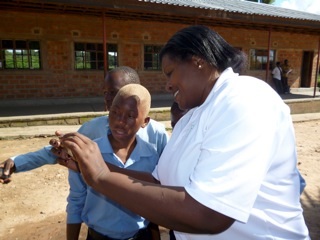
Twaibu is up first.
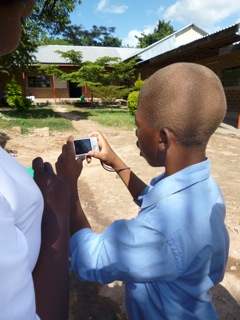
We thought this, in itself, was a beautiful shot of the property.

Twaibu’s first photo!
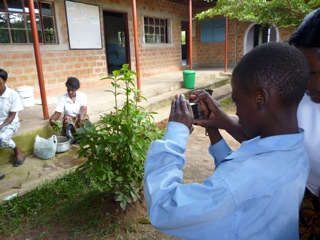
Adrien’s turn.
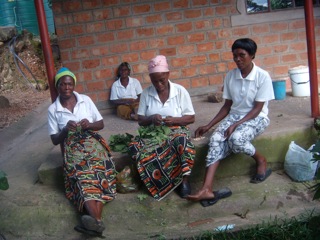
Adrien’s first photo! Here we learned how to say, “May I take your photograph?” And then, “Smile!”
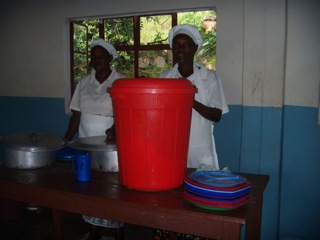
Osric’s first photo!
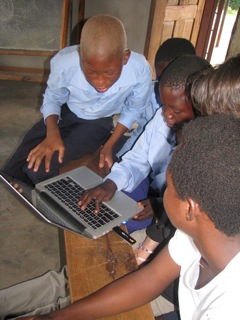
Now, back in the News Room we download the photos and write captions.
As we were writing captions, we stumbled onto a very fun “game” of typing to each other instead of talking. We discovered (so obvious once we saw it) that they can understand far more when we type than when we speak! Here is a small piece of our conversation:
Jen: Mirriam, can type whatever you would like to.
Mirriam: Daer jen,
I would like to learn computers!
Jen: Dear Mirriam,
Great! Who else would like to learn?
Twaibu: Dear jen
Great! I will tell you something.
Jen: Thanks, Twaibu and everyone!! We have to go for today but let’s meet again tomorrow.
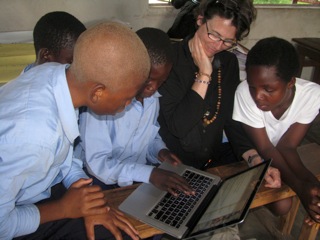
Each student getting a bit of typing time.

And a group shot of the whole News Team.
Stay tuned to Theresa’s weekly blogs to see the work of these budding reporters. (Sign up to get the news from Kantalomba!)
As the English and literacy skills of some of the Grade 6 and 7 students (especially girls) improve, we plan to invite them into this process as well. At the end of the day, as we were discussing how effective the attendance charts are, Theresa told us about a conversation she had with Estella, one of the cooperative members. Estella has two daughters who are at that very vulnerable age in Kantolomba: 11 and 13. She was telling Theresa that she is beginning to have difficulty with them—not listening to her, not doing their chores at home, staying out… All normal teenage sorts of things anywhere in the world, but here the stakes are so high. Estella was saying that she is very encouraged by the Living English program, especially that the children will be exposed to a wider range of what is possible for them than they see in Kantolomba. “Maybe this program will help my daughters escape the Kantolomba disease.”
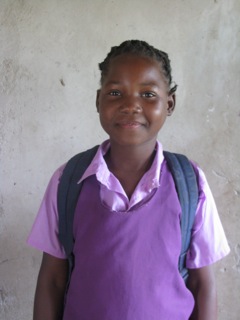
Karen, Joanne’s oldest child. A beautiful example of what motivates all of us!
